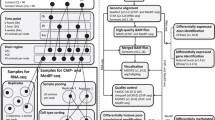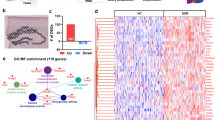Abstract
Many experiments in the past have demonstrated the requirement of de novo gene expression during memory formation. In contrast to the initial reductionistic view that genes relevant to learning and memory would be easily found and would provide a simple key to understand this brain function, it is becoming apparent that the genetic contribution to memory is complex. Previous approaches have been focused on individual genes or genetic pathways and failed to address the massively parallel nature of genome activities and collective behavior of the genes that ultimately control the molecular mechanisms underlying brain function. In view of the broad variety of genes and the cross talk of genetic pathways involved in this regulation, only gene expression profiles may reflect the complete behavior of regulatory pathways. In this review we illustrate how DNA microarray-based gene expression profiling may help to dissect and analyze the complex mechanisms involved in gene regulation during the acquisition and storage of memory in the mammalian brain.
Similar content being viewed by others
REFERENCES
James, W. 1890. The Principles of Psychology, New York, Holt, Rinehart and Winston.
Davis, H. P. and Squire, L. R. 1984. Protein synthesis and memory: a review. Psychol. Bull. 96:518-559.
Stork, O. and Welzl, H. 1999. Memory formation and the regulation of gene expression. Cell. Mol. Life Sci. 55:575-592.
Cavallaro, S., Meiri, N., Yi, C., Musco, S., Ma, W., Goldberg, J., and Alkon, D. L. 1997. Late memory-related genes in the hippocampus revealed by RNA fingerprinting. Proc. Natl. Acad. Sci. USA 94:9669-9673.
Zhao, W., Meiri, N., Xu, H., Cavallaro, S., Quattrone, A., Zhang, L., and Alkon, D. L. 2000. Spatial learning induced changes in expression of the ryanodine type II receptor in the rat hippocampus. FASEB J. 14:290-300.
Arnone, M. I. and Davidson, E. H. 1997. The hardwiring of development: organization and function of genomic regulatory systems. Development 124:1851-1864.
Miklos, G. L. and Rubin, G. M. 1996. The role of the genome project in determining gene function: insights from model organisms. Cell 86(4):521-529.
The Chipping Forecast. 1999. Nat. Genet. 21, Suppl.
Eisen, M. B., Spellman, P. T., Brown, P. O., and Botstein, D. 1998. Cluster analysis and display of genome-wide expression patterns. Proc. Natl. Acad. Sci. USA 95(25):14863-14868.
Cavallaro, S., Schreurs, B. G., Zhao, W., D'Agata, V., and Alkon, D. L. 2001. Gene expression profiles during long-term memory consolidation. Eur. J. Neurosci. 13:1809-1815.
Gormezano, I., Schneiderman, N., Deaux, E., and Fuentes, I. 1962. Nictitating membrane: Classical conditioning and extinction in the albino rabbit. Science 138:33-35.
Yeo, C. H., Hardiman, M. J., and Glickstein, M. 1985. Classical conditioning of the nictitating membrane response of the rabbit. Exp. Brain Res. 60:99-113.
Berthier, N. E. and Moore, J. W. 1986. Cerebellar Purkinje cell activity related to the classically conditioned nictitating membrane response. Exp. Brain Res. 63:341-350.
Schreurs, B. G., Sanchez-Andres, J. V., and Alkon, D. L. 1991. Learning-specific differences in Purkinje-cell dendrites of lobule HVI (Lobulus simplex): intracellular recording in a rabbit cerebellar slice. Brain Res. 548:18-22.
Gruart, A. and Yeo, C. H. 1995. Cerebellar cortex and eyeblink conditioning: bilateral regulation of conditioned responses. Exp. Brain Res. 104:431-438.
Gould, T. J. and Steinmetz, J. E. 1996 Changes in rabbit cerebellar cortical and interpositus nucleus activity during acquisition, extinction, and backward classical eyelid conditioning. Neurobiol. Learn. Mem. 65:17-34.
Schreurs, B. G., Tomsic, D., Gusev, P. A., and Alkon, D. L. 1997. Dendritic excitability microzones and occluded long-term depression after classical conditioning of the rabbit's nictitating membrane response. J. Neurophysiol. 77:86-92.
Schreurs, B. G., Gusev, P. A., Tomsic, D., Alkon, D. L., and Shi, T. 1998. Intracellular correlates of acquisition and longterm memory of classical conditioning in Purkinje cell dendrites in slices of rabbit cerebellar lobule HVI. J. Neurosci. 18:5498.
Coulter, D. A., Lo Turco, J. J., Kubota, M., Disterhoft, J. F., Moore, J. W., and Alkon, D. L. 1989. Classical conditioning reduces amplitude and duration of calcium-dependent afterhyperpolarization in rabbit hippocampal pyramidal cells. J. Neurophysiol. 61:971-981.
Sanchez-Andres, J. V. and Alkon, D. L. 1991. Voltage-clamp analysis of the effects of classical conditioning on the hippocampus. J. Neurophysiol. 65:796-807.
Molchan, S. E., Sunderland, T., McIntosh, A. R., Herscovitch, P., and Schreurs, B. G. 1994. A functional anatomical study of associative learning in humans. Proc. Natl. Acad. Sci. USA 91:8122-8126.
Logan, C. G. and Grafton, S. T. 1995. Functional anatomy of human eyeblink conditioning determined with regional cerebral glucose metabolism and positron-emission tomography. Proc. Natl. Acad. Sci. USA 92:7500-7504.
Blaxton, T. A., Zeffiro, T. A., Gabrieli, J. D. E., Bookheimer, S. Y., Carrillo, M. C., Theodore, W. H., and Disterhoft, J. F. 1996. Functional mapping of human learning: a positron emission tomography activation study of eyeblink conditioning. J. Neurosci. 16:4032-4040.
Schreurs, B. G., McIntosh, A. R., Bahro, M., Herscovitch, P., Sunderland, T., and Molchan, S. E. 1997. Lateralization and behavioral correlation of changes in regional cerebral blood flow with classical conditioning of the human eyeblink response. J. Neurophysiol. 77:2153-2163.
Alberini, C. M., Ghirardi, M., Metz, R., and Kandel, E. R. 1994. C/EBP is an immediate-early gene required for the consolidation of long-term facilitation in Aplysia. Cell 76:1099-1114.
Nieto-Bona, M. P., Garcia-Segura, L. M., and Torres-Aleman I. 1997. Transynaptic modulation by insulin-like growth factor 1 of dendritic spines in Purkinje cells. Int. J. Dev. Neurosci. 15:749-754.
Castro-Alamancos, M. A. and Torres-Aleman, I. 1993. Longterm depression of glutamate-induced gamma-aminobutyric acid release in cerebellum by insulin-like growth factor 1. Proc. Natl. Acad. Sci. USA 90:7386-7390.
Aleman, A., de Vries, W. R., de Haan, E. H., Verhaar, H. J., Samson, M. M., and Koppeschaar, H. P. 2000. Age-sensitive cognitive function, growth hormone and insulin-like growth factor 1 plasma levels in healthy older men. Neuropsychobiol. 41:73-78.
Markowska, A. L., Mooney, M., and Sonntag, W. E. 1998. Insulin-like growth factor-1 ameliorates age-related behavioral deficits. Neuroscience 87:559-569.
Taubenfeld, S. M., Wiig, K. A., Monti, B., Dolan, B., Pollonini, G., and Alberini, C. M. 2001 Fornix-dependent induction of hippocampal CCAAT enhancer-binding protein ta and δ co-localizes with phosphorylated cAMP response element-binding protein and accompanies long-term memory consolidation. J. Neurosci. 21:84-91.
Sterneck, E., Paylor, R., Jackson-Lewis, V., Libbey, M., Przedborski, S., Tessarollo, L., Crawley, J. N., and Johnson, P. F. 1998. Selectively enhanced contextual fear conditioning in mice lacking the transcriptional regulator CCAAT/enhancer binding protein delta. Proc. Natl. Acad. Sci. USA 95:10908-10913.
Osborne, L. R., Campbell, T., Daradich, A., Scherer, S. W., and Tsui, L. C. 1999. Identification of a putative transcription factor gene (WBSCR11) that is commonly deleted in Williams-Beuren syndrome. Genomics 57:279-284.
Author information
Authors and Affiliations
Rights and permissions
About this article
Cite this article
Cavallaro, S., D'Agata, V. & Alkon, D.L. Programs of Gene Expression During the Laying Down of Memory Formation as Revealed by DNA Microarrays. Neurochem Res 27, 1201–1207 (2002). https://doi.org/10.1023/A:1020933627597
Issue Date:
DOI: https://doi.org/10.1023/A:1020933627597




